一、文件上传
1、普通文件上传
新建页面WebContent/file.jsp
<%@ page language="java" contentType="text/html; charset=utf-8"
pageEncoding="utf-8"%>
<!DOCTYPE html PUBLIC "-//W3C//DTD HTML 4.01 Transitional//EN" "http://www.w3.org/TR/html4/loose.dtd">
<html>
<head>
<meta http-equiv="Content-Type" content="text/html; charset=utf-8">
<title>Insert title here</title>
</head>
<body>
<form action="upload" method="post" enctype="multipart/form-data">
文件描述:<input type="text" name="desc"/><br/>
选择文件:<input type="file" name="myfile"/><br/>
<input type="submit" value="上传">
</form>
</body>
</html>新建控制器src/controller/FileUploadController.java
package kshon.controller;
import java.io.File;
import java.io.IOException;
import javax.servlet.http.HttpServletRequest;
import org.apache.commons.io.FileUtils;
import org.springframework.http.HttpHeaders;
import org.springframework.http.HttpStatus;
import org.springframework.http.MediaType;
import org.springframework.http.ResponseEntity;
import org.springframework.stereotype.Controller;
import org.springframework.ui.Model;
import org.springframework.web.bind.annotation.ModelAttribute;
import org.springframework.web.bind.annotation.RequestMapping;
import org.springframework.web.bind.annotation.RequestMethod;
import org.springframework.web.bind.annotation.RequestParam;
import org.springframework.web.multipart.MultipartFile;
import kshon.pojo.FileUpload;
@Controller
public class FileUploadController {
@RequestMapping(value="upload",method=RequestMethod.POST)
public String upload(HttpServletRequest request,
@RequestParam("desc") String desc,
@RequestParam("myfile") MultipartFile myfile){
System.out.println(desc);
if(!myfile.isEmpty()){
//获取上传路径
String path = request.getServletContext().getRealPath("/images/");
//获取上传文件名
String filename = myfile.getOriginalFilename();
System.out.println("路径:"+path+filename);
File filepath = new File(path,filename);
if(!filepath.getParentFile().exists()){
filepath.getParentFile().mkdirs();
System.out.println("创建目录成功");
}
//将上传的文件保存到目标路径中
try {
myfile.transferTo(filepath);
} catch (Exception e) {
// TODO Auto-generated catch block
e.printStackTrace();
}
return "success";
}
return "error";
}WEB-INF/web.xml文件
<?xml version="1.0" encoding="UTF-8"?>
<web-app xmlns:xsi="http://www.w3.org/2001/XMLSchema-instance" xmlns="http://java.sun.com/xml/ns/javaee" xsi:schemaLocation="http://java.sun.com/xml/ns/javaee http://java.sun.com/xml/ns/javaee/web-app_3_0.xsd" id="WebApp_ID" version="3.0">
<display-name>SpringMVC</display-name>
<welcome-file-list>
<welcome-file>index.html</welcome-file>
<welcome-file>index.htm</welcome-file>
<welcome-file>index.jsp</welcome-file>
<welcome-file>default.html</welcome-file>
<welcome-file>default.htm</welcome-file>
<welcome-file>default.jsp</welcome-file>
</welcome-file-list>
<servlet>
<servlet-name>springmvc</servlet-name>
<!-- 前端控制器 -->
<servlet-class>org.springframework.web.servlet.DispatcherServlet</servlet-class>
<init-param>
<!-- contextConfigLocation是参数名称,该参数的值包含的是springmvc的配置文件路径 -->
<param-name>contextConfigLocation</param-name>
<param-value>/WEB-INF/springmvc-config.xml</param-value>
</init-param>
<!-- 在web应用程序启动时立即加载Servlet -->
<load-on-startup>1</load-on-startup>
</servlet>
<servlet-mapping>
<servlet-name>springmvc</servlet-name>
<url-pattern>/</url-pattern>
</servlet-mapping>
<!-- 配置监听器 -->
<listener>
<listener-class>org.springframework.web.context.ContextLoaderListener</listener-class>
</listener>
<!-- 指定spring的核心文件,必须使用context-param,ContextLoaderListener才能找到 -->
<context-param>
<param-name>contextConfigLocation</param-name>
<param-value>/WEB-INF/springmvc-config.xml</param-value>
</context-param>
</web-app>springmvc的配置文件WEB-INF/springmvc-config.xml
<?xml version="1.0" encoding="UTF-8"?>
<beans xmlns="http://www.springframework.org/schema/beans"
xmlns:xsi="http://www.w3.org/2001/XMLSchema-instance"
xmlns:mvc="http://www.springframework.org/schema/mvc"
xmlns:context="http://www.springframework.org/schema/context"
xsi:schemaLocation="http://www.springframework.org/schema/beans
http://www.springframework.org/schema/beans/spring-beans-4.2.xsd
http://www.springframework.org/schema/mvc
http://www.springframework.org/schema/mvc/spring-mvc-4.2.xsd
http://www.springframework.org/schema/context
http://www.springframework.org/schema/context/spring-context-4.2.xsd">
<!-- spring自动扫描base-package下面的包或子包下面的java文件(用了注解的java类必须被扫描才有效) -->
<context:component-scan base-package="kshon.controller,kshon.pojo" />
<!-- 设置配置方案 -->
<mvc:annotation-driven />
<!-- 使用默认的servlet响应静态文件 -->
<mvc:default-servlet-handler/>
<!-- 配置annotation类型的处理映射器 -->
<bean class="org.springframework.web.servlet.mvc.method.annotation.RequestMappingHandlerMapping"/>
<!-- 配置annotation类型的处理器适配器 -->
<bean class="org.springframework.web.servlet.mvc.method.annotation.RequestMappingHandlerAdapter"/>
<!-- 视图解析器 -->
<bean class="org.springframework.web.servlet.view.InternalResourceViewResolver">
<property name="prefix">
<value>/WEB-INF/content/</value>
</property>
<property name="suffix">
<value>.jsp</value>
</property>
</bean>
<!-- 国际化 -->
<bean id="messageSource" class="org.springframework.context.support.ResourceBundleMessageSource">
<property name="basenames" value="message"></property>
</bean>
<!-- 国际化操作拦截器如果采用基于(session/cookie)则必须配置 -->
<mvc:interceptors>
<bean class="org.springframework.web.servlet.i18n.LocaleChangeInterceptor"></bean>
</mvc:interceptors>
<bean id="localeResolver" class="org.springframework.web.servlet.i18n.SessionLocaleResolver"></bean>
<!-- 文件上传 -->
<bean id="multipartResolver" class="org.springframework.web.multipart.commons.CommonsMultipartResolver">
<!-- 上传文件大小限制 -->
<property name="maxUploadSize">
<value>10485760</value>
</property>
<!-- 请求的编码格式,需与jsp页面的编码一致,方便正确读取,默认编码为ISO-8859-1 -->
<property name="defaultEncoding">
<value>UTF-8</value>
</property>
</bean>
</beans>运行tomcat,输入http://localhost:8080/SpringMVC/file.jsp
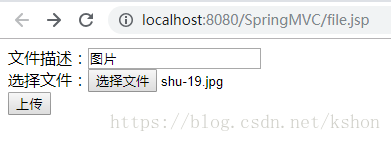
接下来在tomcat中的springMVC项目中查看

2、基于对象的文件上传
在src/pojo目录下新建一个FileUpload.java类
package kshon.pojo;
import org.springframework.web.multipart.MultipartFile;
public class FileUpload {
private String name;
private MultipartFile file;
public String getName() {
return name;
}
public void setName(String name) {
this.name = name;
}
public MultipartFile getFile() {
return file;
}
public void setFile(MultipartFile file) {
this.file = file;
}
}
在src/controller/FileUploadController.java中增加一个方法
@RequestMapping(value="fileUpload",method=RequestMethod.POST)
public String fileUpload(@ModelAttribute FileUpload fileUpload,
Model model,
HttpServletRequest request){
if(!fileUpload.getFile().isEmpty()){ //如果上传的文件不为空
String path = request.getServletContext().getRealPath("/images"); //获取项目路径下的images目录
String filename = fileUpload.getFile().getOriginalFilename(); //获取上传的文件名
File file = new File(path,filename); //合并路径和文件名
if(!file.getParentFile().exists()){ //判断images目录是否存在,不存在则创建
file.getParentFile().mkdirs();
}
try {
//将上传文件 移动到目标文件
fileUpload.getFile().transferTo(file);
//将上传文件信息存到model
model.addAttribute("fileUpload", fileUpload);
System.out.println(path+File.separator+filename);
} catch (IllegalStateException e) {
// TODO Auto-generated catch block
e.printStackTrace();
} catch (IOException e) {
// TODO Auto-generated catch block
e.printStackTrace();
}
return "filelist";
}
return "error";
}修改页面WebContent/file.jsp
<%@ page language="java" contentType="text/html; charset=utf-8"
pageEncoding="utf-8"%>
<!DOCTYPE html PUBLIC "-//W3C//DTD HTML 4.01 Transitional//EN" "http://www.w3.org/TR/html4/loose.dtd">
<html>
<head>
<meta http-equiv="Content-Type" content="text/html; charset=utf-8">
<title>Insert title here</title>
</head>
<body>
<form action="fileUpload" method="post" enctype="multipart/form-data">
文件描述:<input type="text" name="name"/><br/>
选择文件:<input type="file" name="file"/><br/>
<input type="submit" value="上传">
</form>
</body>
</html>启动tomcat,输入http://localhost:8080/SpringMVC/file.jsp
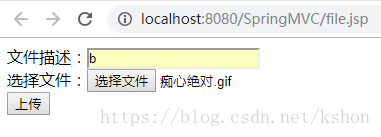
接下来在tomcat中的springMVC项目中查看
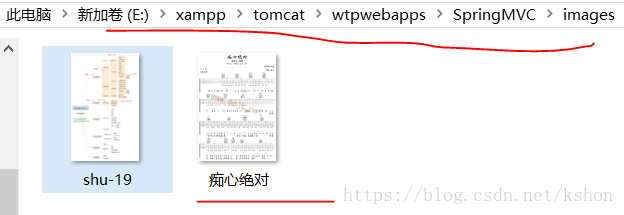
二、文件下载
在WEB-INF/content目录下新建filelist.jsp页面
<%@ page language="java" contentType="text/html; charset=utf-8"
pageEncoding="utf-8"%>
<!DOCTYPE html PUBLIC "-//W3C//DTD HTML 4.01 Transitional//EN" "http://www.w3.org/TR/html4/loose.dtd">
<html>
<head>
<meta http-equiv="Content-Type" content="text/html; charset=utf-8">
<title>Insert title here</title>
</head>
<body>
<a href="download?filename=${requestScope.fileUpload.file.originalFilename}">下载文件</a>
${requestScope.fileUpload.file.originalFilename}
</body>
</html>在src/controller/FileUploadController.java中增加一个方法
@RequestMapping("download")
public ResponseEntity<byte[]> download(HttpServletRequest request,
@RequestParam("filename") String filename,
Model model) throws IOException{
//下载目录
String path = request.getServletContext().getRealPath("/images");
File file = new File(path,filename);
//设置编码类型
String downloadName = new String(filename.getBytes("UTF-8"),"iso-8859-1");
HttpHeaders headers = new HttpHeaders();
//通知浏览器以attachment(下载文件)的方式打开浏览器
headers.setContentDispositionFormData("attachment", downloadName);
//application/octet-stream:二进制流数据(最常见的下载方式)
headers.setContentType(MediaType.APPLICATION_OCTET_STREAM);
return new ResponseEntity<byte[]>(FileUtils.readFileToByteArray(file),headers,HttpStatus.CREATED);
}启动tomcat,输入http://localhost:8080/SpringMVC/file.jsp
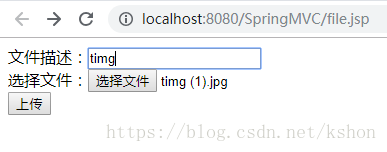
点击上传后,跳转到WEB-INF/content/filelist.jsp页面

点击下载文件,即可看到文件选择框
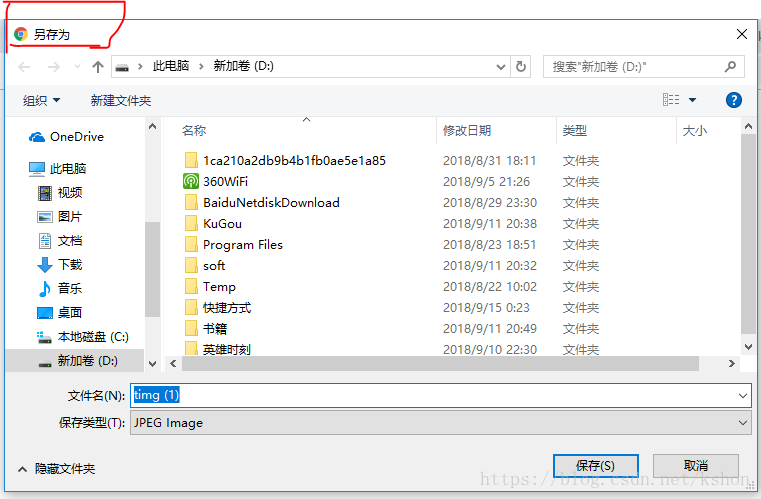





 本文介绍如何在SpringMVC框架中实现文件上传和下载功能。包括普通文件上传、基于对象的文件上传及文件下载的详细步骤和代码示例。
本文介绍如何在SpringMVC框架中实现文件上传和下载功能。包括普通文件上传、基于对象的文件上传及文件下载的详细步骤和代码示例。
















 1064
1064

 被折叠的 条评论
为什么被折叠?
被折叠的 条评论
为什么被折叠?








